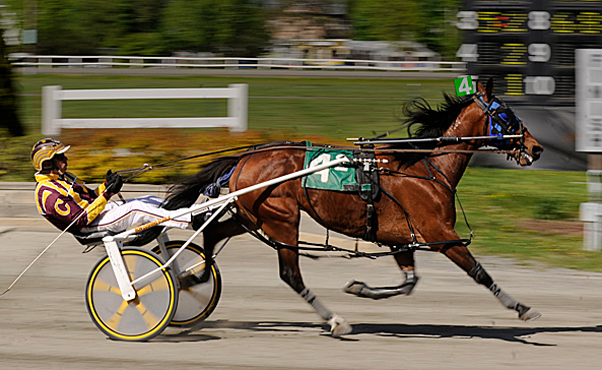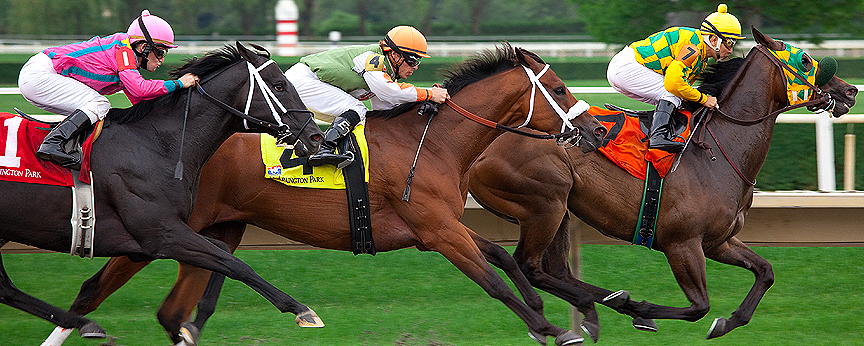![]()
Horse racing is one of the oldest sports-betting genres, and also happens to be one of the most exciting and entertaining events that sports has to offer.
Unfortunately, horse races tend to get lumped together, and the casual sports bettor often doesn’t know that there are many different events, and in turn, several different types of horse racing.
Contrary to popular belief, the three races run in the Triple Crown are not the only important horse racing events in the calendar year. Those races aren’t the only types of horse racing, either.
Some races put an emphasis on speed, while others track endurance or specific skills. There are also horse races that feature specific types of horses or grade horses competing at a certain level.
It’s important to know which is which before you ever place money on a wager, as some types of horse racing are far more worth your time than others. Here’s a look at the most common types of horse racing:

Flat Racing
The most popular type of horse racing by far is flat racing. These types of races typically deal with Thoroughbred horses, and are run on a flat, leveled surface.
In North America, the Triple Crown events (Kentucky Derby, Preakness Stakes, and Belmont Stakes) are easily the most popular, but any race that is run on a flat surface without hurdles or other obstacles for the horses typically qualifies as a flat race.
Flat races tend to be run between 1-3 miles, depending on the event, and can be a test of the horse’s speed, stamina, or both. Turf is the leading running surface for horses across the world, but many races are still held on dirt tracks as well, especially in the United States.
In Great Britain and Europe, flat racing is often broken down into two classifications:
- Conditions Racing
- Handicap Racing
Conditions and Handicap races both refer to distinct handicaps set for horses ahead of a given event. Conditions races are decided based on various elements, whether it be the horses’ age, sex, or another distinction.
Horses seen to have an initial advantage carry extra weight to give the rest of the field a handicap, which effectively balances things out and gives bettors more of a leveled playing field.
Handicap races are different in the sense that any given handicap is decided by the handicapper, and the handicap is not based on the horse’s sex or age.
Handicappers consider horse speed, pace, form, class, post position, pedigree, the horse’s jockey, and any other relevant factors that can accurately handicap the race.
The Triple Crown races, along with the Breeders’ Cup Classic, are some of the most well-known flat races in the United States.
There are also several popular flat racing events overseas, with the “classic races” taking center stage. Those are all quite well known, and shown below:
These are the rare horse racing events overseas that are flat racing events that do not include jumps.

Jump Racing (National Hunt)
Jump racing, referred to as National Hunt, gives the horses obstacles to overcome beyond just the track length or the surrounding competition.
National Hunt is the official name of jump racing overseas, where horses avoid fences, ditches, or other obstacles as they compete to win races. These races are incredibly popular in France, Ireland, and the United Kingdom.
Jump races can be a bit more difficult to bet on, as bettors need to consider a lot of different variables, with horse’s hurdling ability and jockey control being arguably the most important.
Also referred to as Steeplechasing, jump racing is divided into two separate sects:
Hurdles races have horses race while jumping over obstacles called hurdles, while Steeplechase racing has horses leap over numerous obstacles, which can include fences, water, and open ditches.
Today, the two biggest jump racing events are the Cheltenham Gold Cup and the Aintree Grand National. The latter is regarded as the most prestigious National Hunt event, and is run in April each year.
Other jump racing events that have been held in high regard are the King George VI Chase and the Hennessy Gold Cup.
A separate type of horse racing that fits under jump racing is Point to Point racing, which is specifically jump racing for amateurs.

Endurance Racing
The third main type of horse racing is endurance racing, which challenges horses over longer tracks, or at least for longer periods of time.
Unlike many of the popular flat and jump racing events, endurance racing tests endurance and longevity on a track. Speed isn’t as big of a factor here for bettors, as the main focus is on horses that have the ability to produce consistently and not fade over larger courses.
This isn’t a hugely-popular horse racing style, just because it can take far longer and isn’t necessarily ideal for horses and jockeys. The longest endurance race going on currently is the Mongol Derby, which stretches for a ridiculous 1,000 kilometers.
All breeds are welcome for these types of races, but Arabian horses tend to be popular, due to their elite stamina and endurance.

Harness Racing
There are also races where the horse is responsible for more than just its own weight and a jockey. In harness racing, horses pull a sulky, and race a specific trot or pace.

The goal is for the horses to trot or pace at the predetermined speed, without breaking stride. Horses are penalized for galloping by being forced to slow down behind the competition.
Easily the top harness race in the world is the Prix d’Amerique, which is held yearly in Paris. Horses are entered into this prestigious event based on lifetime earnings, and compete for a prize upwards of 1 million euros.

Quarter Horse Racing
A less popular type of horse racing is quarter horse racing, which puts an extreme emphasis on speed. Quarter horse races refer to a quarter of a mile or less, which challenges faster breeds of horses to compete and win on very short tracks.
These horse racing events can be exciting due to the speed and talent involved, but they don’t last very long.
The American Quarter Horse can run a quarter of a mile in as fast as 22 seconds,
and are routinely faster than some of the fastest Thoroughbreds.
Quarter horse racing isn’t as popular as some other events, but bettors can still keep tabs on speed events like the All American Futurity at Ruidoso Downs.

Maiden Racing
There are two ways to look at horse racing types. One is the actual track, the obstacles, and distance a race deals with.
The other is what type of horse is allowed in the race and what is at stake. This next sect of horse racing types deals more with the graduation of racing for horses.
With that, maiden racing is not necessarily restricted to any one type of horse racing, but instead simply refers to horses that have yet to win a race. Horses remain a maiden until they notch their first win, which gives way to races set up specifically for horses that haven’t done so.
A horse securing a victory at a maiden race isn’t overly impressive, but it gets them going in the right direction. With the competition coming into each race with zero victories, maiden races can be incredibly tough to gauge.
One great strategy is tracking past maiden races and seeing which horses have come close to winning (finishing in top three), or start/finish strongly.

Allowance and Claiming Racing
There are also horse races where horses are run for profit, but at the same time are showcased for sale. These are not popular races due to a serious lack of reliability, as well as the obvious goal of horses being purchased.
![Jockey and Horse Competing in Starlight Race]()
Of course, these two racing types are quite different. Allowance races offer a much bigger purse than claiming races, and the horses aren’t actually for sale.
These races aren’t graded and really aren’t that important in the grand scheme of things, but there is still a good amount of money involved, and the horses involved can prove themselves for bigger events in the future.
Claiming races are the races where horses compete to win, but owners are also gauging their value. Much like maiden races, this is a low level of horse racing, and not an ideal horse racing betting atmosphere.
Ahead of claiming races, people can put in claims to bid and purchase a horse. Should that horse finish in the money, the previous owner gets the purse, while the new owner would then get the horse.

Stakes Racing
Once a horse has really proven itself, they can start racing in stakes events. These are the highest level of horse races, and tend to feature huge cash prizes.

Some of the best owners, trainers, jockeys, and horse racing talent are in these races, and this is the first big stepping stone to some of the biggest horse racing events.
Any horse that ends up running in the biggest events usually has to work its way up the ladder, which has the average horse competing in at least a handful of stakes races. These races tend to be of the flat racing variety (especially in North America) and are typically well-known events on the circuit.
There are low level stakes races and there are higher level events that horses can use to push them into big events like the Kentucky Derby.

Graded Stakes Racing
The last type of horse racing is graded stakes racing, where the race is assigned a grade (I, II, or III) that helps detail which horses are the most competitive, as well as the quality of the field.
These graded stakes can serve as measuring sticks for owners, trainers, jockeys, and the horses, while the horse racing community can gauge just how good a horse is based on how they compete and finish.
Grades stakes events can feature different lengths and tracks and can serve as huge stepping stones toward bigger events. These races also tend to showcase large purses, and on their own can register as big wins or placements for horses who take first, second, or third.
Some intermediate grades stakes races like the Arkansas Derby, Santa Anita Derby, and Travers Stakes are well known for their overall quality, difficulty, and competition. Any horse who takes these events (among others) is immediately respected for obtaining a big win.
Bigger graded stakes events like the Kentucky Derby, Preakness Stakes, and the Belmont are more well-known and tend to be the final destination that other graded stakes races get horses to.
For the most part, when betting on big horse racing events in the United States, bettors will be dealing with flat racing, Thoroughbreds, and various levels of stakes racing. These are the races that are highly publicized, get the most national attention, and also garner the most information to accurately bet on.
All other events are much more specific to their style, country, or sect, and require studious research and betting insight.


 Flat Racing
Flat Racing





